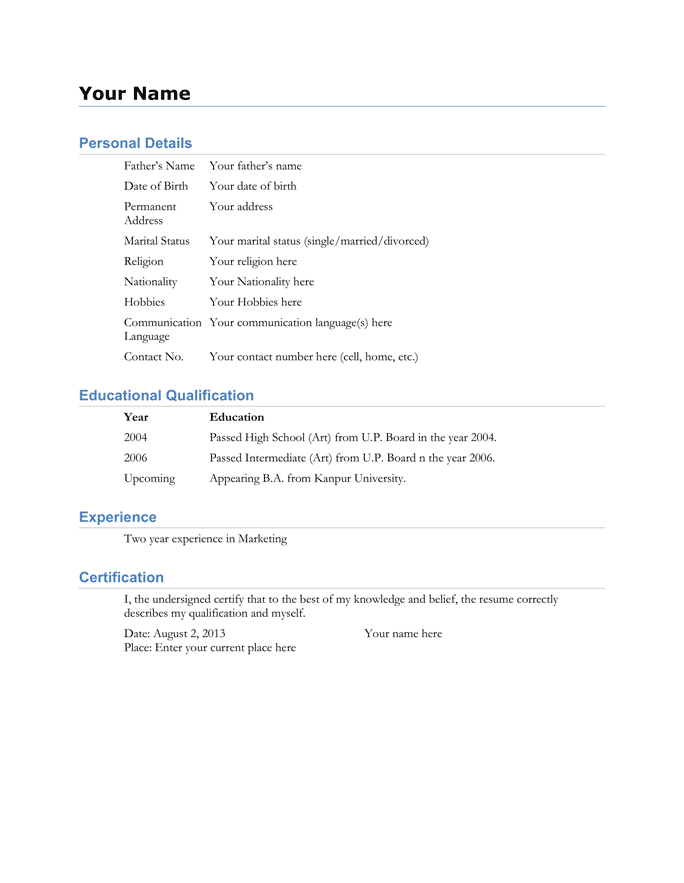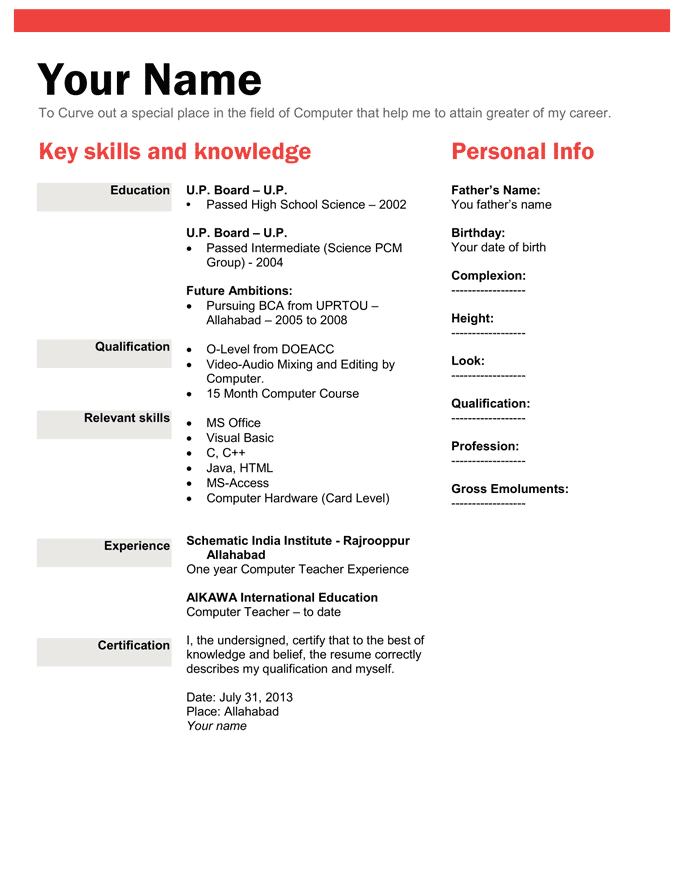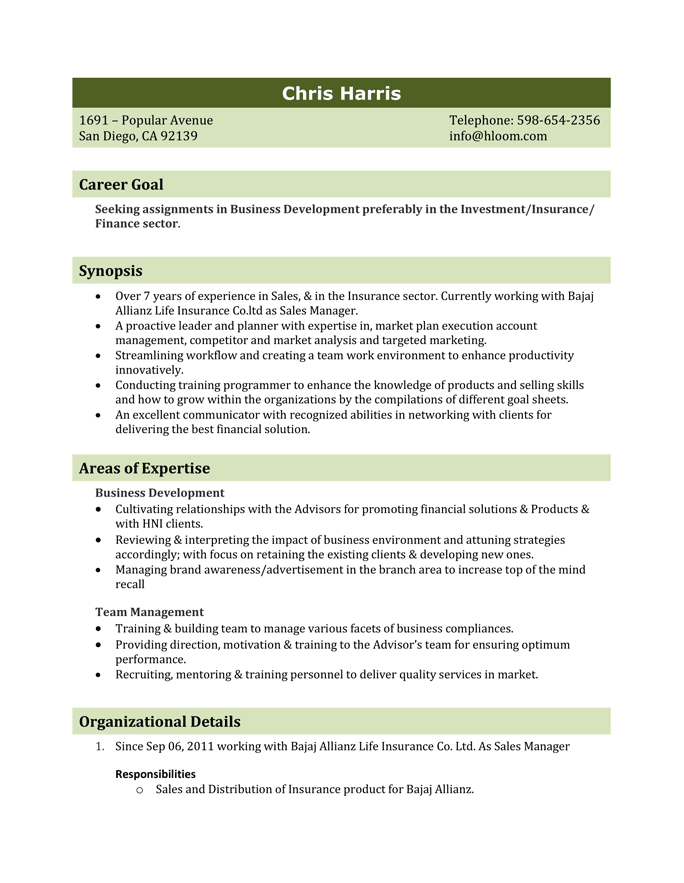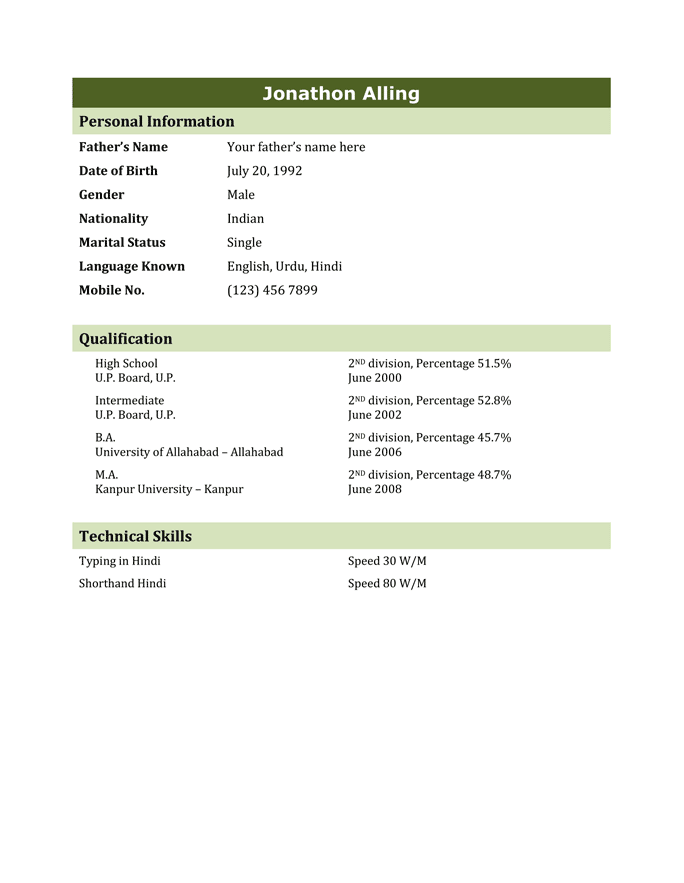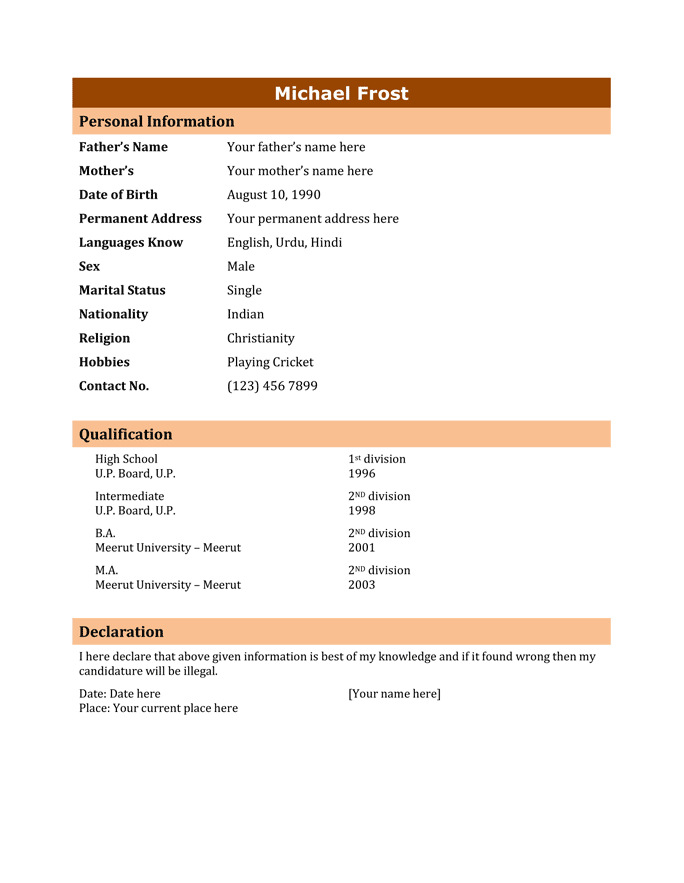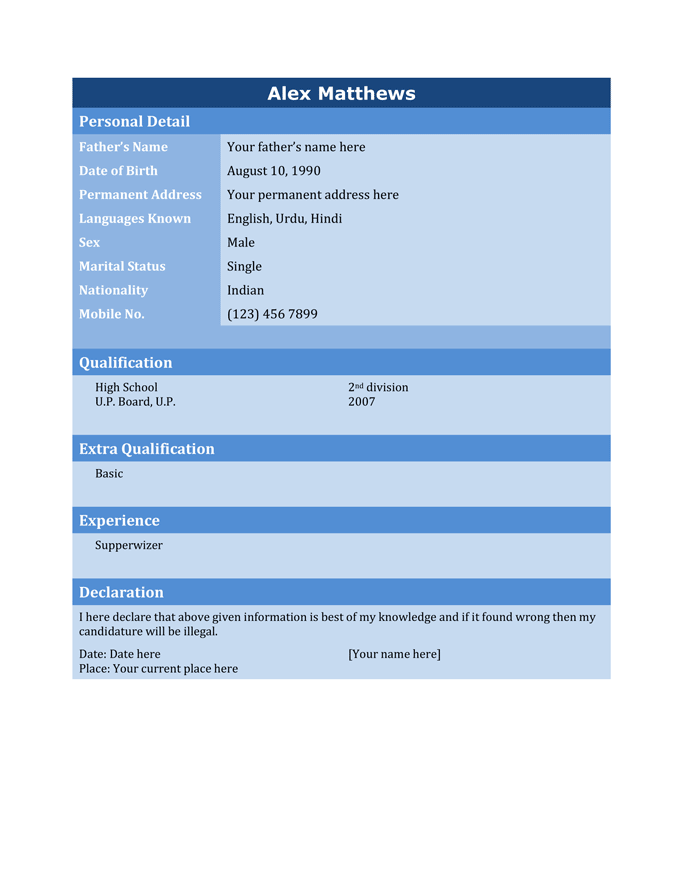Biodata Resume Templates For 2024

- Featured In:

Table of Contents
Here are more resources that can help you
-
Resume/CV Templates
-
- Basic Resume Template
- Creative Resume Template
- Portfolio Resume Template
- Modern Resume Template
- ATS Resume Template
- One-Page Resume Template
- Google Docs Resume Template
- CV Template
- Biodata Resume Template
- Writer Resume Example
- High School Student Resume Example
- Internship Resume Example
- Entry Level Resume Example
- Massage Therapist Resume Example
- Medical Assistant Resume Example
- Cashier Resume Example
- BabySitter Resume Example
- Customer Service Example
- Attorney Resume Example
- Customer Service Representative Resume Example
- Teacher Resume Example
- Engineering Resume Example
- Nurse Resume Example
- Latex Resume Template
- College Student Resume Example
- High School Graduate Resume Example
-
Resume Help
Premium Biodata Resume
Use our professional biodata resume templates to help you get your next job. Download an example and get started today!
-
Professional biodata resume
-
Prospective groom marriage biodata resume
-
Prospective bride marriage biodata resume
Choose from our premade resume templates and download your winning resume today.
Free Biodata Templates
What is a Biodata Resume?
A biodata resume differs from a standard resume by including personal information about the applicant alongside their professional training and accomplishments. This specialized resume is typically used for both employment and marriage opportunities in some South Asian countries, including:
- India
- Bangladesh
- Pakistan
- Sri Lanka
A biodata resume can be used for any of the following situations, depending on the context and setting:
- A criterion-related validity assessment used by employers for personnel selection
- A supplement to a resume or CV
- A resume replacement in some South Asian regions
- For applying to government jobs in India
- To apply for temporary and/or skilled labor jobs in some countries
- As a marriage resume in India or Pakistan
A classic biodata format includes factual personal and professional information about an individual such as:
- Personal information: date of birth, gender, marital status, religion, height, complexion, father’s name, etc.
- Educational background: Number of degrees, fields of study, and professional training.
- Occupational history: List of former employers, dates of employment, career advancements, and current salary or income.
- Skills sets: Soft, hard, and technical skills related to professional and personal achievements.
- Interests and hobbies
Biodata format documents should not be confused with biodata instruments, or biographical information blanks (BIBs). The former is a document typically prepared by the individual and, in some settings, can serve as a replacement for, or a supplement to, a resume or CV.
Career Biodata Resume Versus Marriage Biodata Resume
Career-focused
For an employer, the biodata format serves as a personal and professional profile summary. It’s a window into the life of the individual that gives the reader insight into who they are. A career biodata resume will typically include the following information:
- Objective: Let the recipient know your overall career/life objective, and why you should be considered for the position.
- Personal details: Includes general information such as your name, postal address, date of birth, gender, parents’ names, religion, and more. Also list your hobbies, interests, passions, strengths, characteristics and anything else that helps the recipient understand who you are and what you want to accomplish in life.
- Educational background: List, in chronological order, your academic profile and achievements, particularly those that are relevant to what you are applying for.
- Experience: List, in chronological order, your occupational history, as well as skills obtained, awards received and other professional achievements.
From the biodata, the recipient will be looking to answer questions like:
- Is this candidate a good fit for the position?
- Does this candidate have the personal and psychological characteristics to work well with other team members?
- Does this candidate have the personal qualities to be successful?
- Do they have the potential to grow and enhance their skill set?
Some companies have very specific guidelines for how the biodata resume is structured. In some cases, they will even provide their own pre-printed form for you to fill out during the application process. If you are not given a set format guideline, you can use any of our free biodata templates or use the instructions below to create a premium biodata resume yourself.
Marriage-focused
The biodata format is used for more than just a resume or CV replacement/enhancement. A marriage biodata, also known as a matrimonial biodata or a marriage resume, are still used in countries where arranged marriages are common, such as India and Pakistan.
A matrimonial biodata includes extensive personal information about the individual, and is designed to help the recipient determine whether or not the individual would be an appropriate marriage partner.
The marriage biodata should highlight the personal traits a potential marriage partner might find attractive. A typical marriage resume format may include the following:
- General information: Name, parents’ names, date of birth, family details, caste, educational background and profession.
- Appearance: Height, weight, build, hair and eye color, facial appearance and complexion. Also be sure to insert your best photograph into this section.
- Contact information: Postal address, email address, landline and mobile phone numbers, and social media information.
- Lifestyle: Hobbies, interests, values, beliefs, opinions, favorite foods and drinks, likes/dislikes, smoker/non-smoker, religious/non-religious, etc.
- Ambition/life goals: Your desires and the things you want to achieve in life.
- Partner expectation: Qualities you hope to find in a partner; such as age, family type, educational background, facial appearance and many others.
Our free biodata templates are designed for employment opportunities, but they can be tailored to fit the requirements of those looking to create a good marriage biodata.
Compare Against Resumes and CVs
- Contact information
- Objective statement
- Professional experience
- Skills
- Education
- Contact information
- Objective statement
- Professional experience
- Skills
- Education
- Contact information
- Objective statement
- Professional experience
- Skills
- Education
- Personal information: date of birth, gender, religion, race, nationality, marital status, residence, parent’s names
- Summary statement
- Summary of qualifications (functional resumes)
- Summary statement
- Research experience
- Teaching experience
- Language skills
- Digital skills
- Conference presentations/attendance
- Honors and awards
- Grants or funding
- Publication
- India
- Pakistan
- Bangladesh
- Sri Lanka
- United States
- EU
- Latin America
- Asia
- Canada
- Australia
- New Zealand
- Academics or research in the U.S.
Make Your Biodata Resume in Under an Hour
If you’d like to build a beautiful biodata resume in minutes, you can use our Resume Builder to get started. We’ll teach you how to add custom biodata resume sections below, but using our builder will also unlock these beautiful, but professional templates.
How to Make Your Biodata Using our Builder
Our builder follows a combination resume format, you can add optional sections and customizable sections to create a detailed professional or marriage biodata resume. We’ll walk you through the process.
- Name (built-in section)
- Contact information (built-in section)
- Personal information (new customized section)
- Summary statement (built-in section)
- Skills (built-in section)
- Work experience (built-in section)
- Interests and hobbies (optional built-in section)
- Affiliations (optional built-in section)
How to format your name and contact information
This section of a biodata resume follows the same structure and layout as an average resume and is an automatic process in our builder. Simply fill in the blanks for the following details and the builder will autoformat this information for you.
- First and last name
- Full mailing address
- Phone number
How to add personal information
This information is unique to the biodata resume and is not an automatic feature in our builder. However, our builder does allow you to add custom sections once you complete your contact info, work experience, skills, education, and summary statement sections.
To create this section, visit your Hloom dashboard and click the resume you wish to upgrade to a biodata resume. You’ll see a left-hand menu next to your resume preview with the following options.
- Spell check
-
Resume sections
- Heading
- Professional summary
- Skills
- Work history
- Education
- Add a section
- Download
Click the “Add a section,” option. You’ll see a right-hand option to “Add Your Own.” Click that choice, write “Personal Information” in the open text box, and click next.
In the open text box, choose the bullet list text format option and include the following information in this order:
- Date of birth (DD/MM/YYYY)
- Marital status (single/married/divorced/widowed)
- Next of kin/emergency contact (full name and number)
- Disability (N/A or list of diagnosed disabilities or genetic disabilities)
- Religion
- Height (XX’XX” or XXX cm)
- Race
- Ethnicity/caste group
- Ambition/life goals
- Partner expectation
Please note: This personal information is rarely included on professional resumes or CVs. You should only include this information in biodata resumes within regions that request this resume format. Employment laws and regulations within certain Western countries make it illegal to request or provide this information and should only be supplied to HR upon hiring.
How to personalize your summary statement
This section of a biodata resume follows the same structure and layout as an average resume and is an automatic process in our builder. If you’re writing a professional resume, focus on what skills and achievement you bring to the hiring manager. If you’re writing a marriage biodata, describe your expectations and what you can provide in the marriage.
How to build up your skills
This section of a biodata resume follows the same structure and layout as an average resume and is an automatic process in our builder. Choose six to eight skills to feature in this section, then move on to the next resume section.
How to display your work experience
This section of a biodata resume follows the same structure and layout as an average resume and is an automatic process in our builder. Unlike a Western resume, which limits your work history to the last 10 years, you’ll want to note your entire professional history in reverse-chronological order.
Start with your current or most recent position and work backwards. Highlight crucial promotions or career advancements in the last 10 years.
Where to add interests and hobbies
This information is not an automatic feature in our builder. However, our builder does allow you to add custom sections once you complete the standard sections.
To create this section, visit your Hloom dashboard and click the resume you wish to upgrade to a biodata resume. You’ll see a left-hand menu next to your resume preview with the following options:
- Spell check
-
Resume sections
- Heading
- Professional summary
- Skills
- Work history
- Education
- Add a section
- Download
Click the “Add a section,” option. You’ll see a right-hand option to “Add Your Own.” Click that choice, write “Interests and Hobbies” in the open text box, and click next.
Choose the bullet list text format and include a list of your various hobbies or personal interests, as well as your level of experience (beginner, intermediate or expert.)
Where to include affiliations
This information is not an automatic feature in our builder, but is commonly requested and has a pre-built option in our additional sections options.
To add this section, visit your Hloom dashboard and click the resume you wish to upgrade to a biodata resume. You’ll see a left-hand menu next to your resume preview with the following options:
- Spell check
-
Resume sections
- Heading
- Professional summary
- Skills
- Work history
- Education
- Add a section
- Download
Click the “Add a section,” option. You’ll see a left-hand option to add “Affiliations.” Click that choice and click next. Our builder offers an autofill option with various well known organizations as well as an open text box that allows you to add unlisted organizations.
Now you are ready to try out our builder. Click here to start editing your biodata resume.
Customer Reviews
Biodata Resume FAQ
In which countries do I need a biodata resume?
Biodata resumes are used in very few regions. You’ll likely find and need a biodata resume in the following countries:
- India
- Pakistan
- Sri Lanka
- Bangladesh
Is a biodata resume better than a resume or a CV?
A biodata isn’t better than a resume or a CV because they are used for different purposes. However, a biodata is your best choice if:
- You’re looking for career opportunities in the aforementioned countries.
- An open job opportunity explicitly requests a biodata resume.
- A personal opportunity that explicitly requests a biodata resume.
Resumes are typically used in the United States and are best for professional opportunities, summarize your career-related accomplishments, and are typically one- to two-pages long.
CVs are typically used in the United States for academic, research, medical, federal, or entertainment-related careers and are the international standard for career opportunities. These documents are highly detailed and can vary in length depending on each applicant’s experience, but can include multiple pages.
How long should my biodata resume be?
Your biodata resume is similar to a resume and is between one- to three-pages long, based on the length of your professional experience and the amount of personal information you include.
Rate our Templates
Gabriela Barcenas
Gaby is Hloom’s resident writer, a certified professional resume writer (CPRW), and a baking enthusiast. She likes to defend the use of the functional resume to her friends in HR. She graduated from the University of San Francisco with a B.A. in English and Creative Writing and wrote about career growth, tech startups, education, fashion, travel and lifestyle culture throughout her career.
Similar Articles

Our resume templates are compatible with Word, Google Docs, and are expertly designed to showcase...
Modified Date: February 15, 2024

Our professional resume examples have been crafted by career experts to help make the application...
Modified Date: March 12, 2024

Best Cover Letter Templates for 2023
A great cover letter starts with an outstanding cover letter template. Hloom’s free cover letter ...
Modified Date: February 05, 2024



